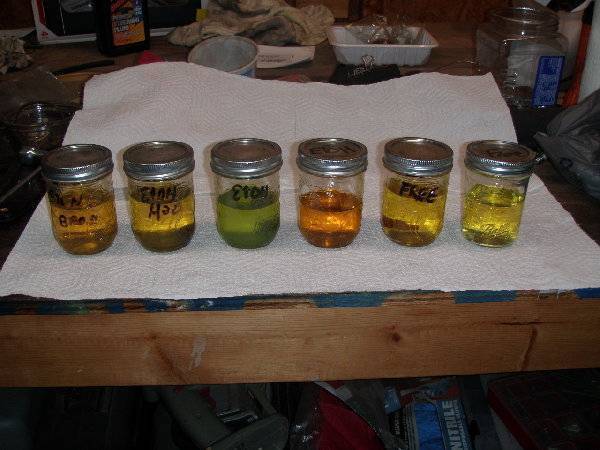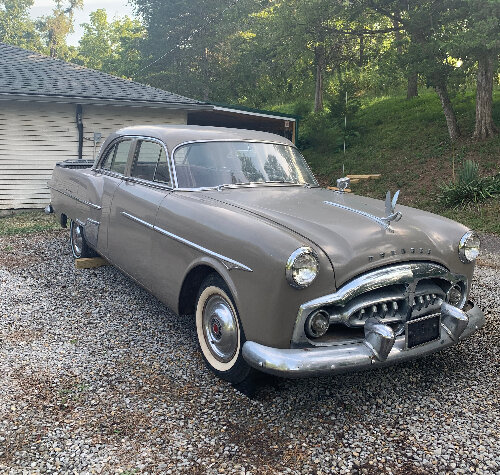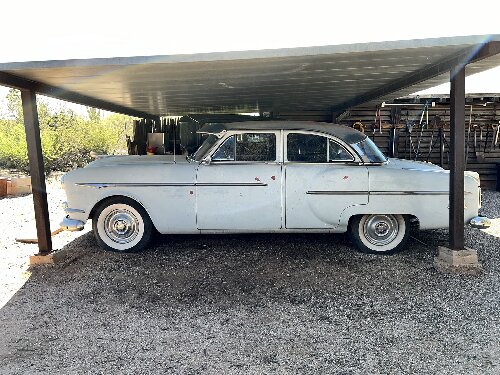|
Re: Oil pressure and mult-viscosity oil.
|
||||
|---|---|---|---|---|
|
Home away from home
|
When you change oil service, you change not just viscosity profile, but additive package. T-4 is made for DIESEL applications, which have much more pressure, soot, and combustion products to contend with. Those additives can loosen some of the accumulated engine sludge from gasoline.
Personally, I do not like to change oil if the engine has not been rebuilt where you're starting with clean surfaces and passages, no sludge. And rarely would I just take someone's word for adding something without investigating. Can not go by sound alone, either. These motors don't have the full pressure filter lubrication we're used to today, mostly partial drip filters, if at all. eg; My '49 has no oil filter. Also, you're only seeing the oil pressure gauge reading, not the actual oil pressure, per se. If it's a mechanical gauge maybe some sludge got in the tube. If sludge gets in the pump intake, it could drop the pressure momentarily too, til it clears out. If it's electric gauge, maybe the pressure was fine and voltage* dropped and/or the regulator was stuck. Contacts systems are a little bit more unreliable than electronic we're used to today. Plus they're that much older now than new. My recommendation; do an oil change, ASAP, and maybe several more, if you keep using this oil, til it clears up. I think the manual calls for a periodic pan drop and scrape on some of these with no filter. But maybe not necessary, but can't know the extent without checking. * - won't take much on a 6V system.
Posted on: 2019/11/11 11:53
|
|||
|
||||
|
Re: Gallons per minute
|
||||
|---|---|---|---|---|
|
Home away from home
|
There should be a 1/4" pipe plug drain on that tank. My '49 (23 series) has one.
MPG is a better indicator of consumption. Delivery is based on rpm, so consumption will vary through out the range.
Posted on: 2019/11/2 9:25
|
|||
|
||||
|
Re: Airplanes - Engines - Aircraft Testing Field
|
||||
|---|---|---|---|---|
|
Home away from home
|
I have real difficulty with why people view and opine about the past and use today's standards as their judging guideline.
One can not re-write history to suit their agenda as many try today on Wikipedia and internet. With airplanes, unlike cars, you get one chance to get it right because if you don't, you fall and crash. Wood isn't that energy absorbing under excessive loads - fails catastrophically. That's why there's a whole other world for aviation specs and regulations or we'd be ducking aircraft more often. Recently one fell into a house, so still happens but not as frequently as when they're shooting at you. Look at how control sophistication has back fired on Boeing. There are limits to current knowledge and understanding in every era.
Posted on: 2019/11/2 9:21
|
|||
|
||||
|
Re: paint color
|
||||
|---|---|---|---|---|
|
Home away from home
|
Another one of "those" issues. "Looks can be deceiving" Today's paint is different than what you got in '46-51, so whom are we kidding that it's restored with original paint?
The paint chemistry changes over the decades, so what's appropriate for one is not necessarily the same in a later. These type "supplier/OEM" parts are usually painted to some spec from a bulk buy paint. Some are not painted. Some paint chips list the under hood and some do not. As far as I can tell in my limited searching, Packard only listed exterior, didn't list all finishes. (We went through this for faux wood. PAC/Stude archives might have documents but certainly "rosters" do not know.) Why good low miles unmolested originals are used as benchmarks. Today's rattle cans are fast dry and come in standard hues. Even these are changing to water based. Automotive mixed paint has 6 finishes, from flat to gloss. All that varies is the amount of "flattener" they mix in. w/ Gloss = 0 flattener, flat = max. I find the mid gloss #3 aka "semi" closely matches GM underhood. For ease, I shoot acrylic enamel for these. I keep rustoleum semigloss black rattle can on the shelf for touchup/small parts. I prefer "appliance" epoxy for unprimed direct to metal coats. This only comes in gloss (rattle cans) so I only use on certain things like cast where the surface won't be extra glossy or making an unseen mounting bracket, etc. You can actually shoot paints in such a way as to reduce gloss, "haze/dry coat", also. Oppositely, you apply a wet coat (with levelers) to bring up an as-sprayed gloss. Epoxy lasts longer/harder and I don't have a gun to clean or 9/10 qt of paint left over. Early pre-war would have been nitrocellulose lacquer and then straight lacquer. Lacquer requires a high solvent content, so is inherently dull from flash off until "rubbed" out, same applies for some other finishes, so what appears to be gloss maybe rubbed and/or waxed to gloss, not as applied. Gloss requires a flat surface. Certainly not unreasonable to wax or rub out a big air cleaner in days past. I know I've done it. The cleaners in wax help a tired old paint finish too. Keeps that dirt off and easier to wash/wipe, too! "Alkyd" is probably post war period what we refer to as "straight" enamel. You can still get, but it takes long to dry w/o an oven, and today most add accelerator or hardener to it. This is what is still used on restoring tractors, etc. Low VOC inherently. Hardener is isocyanate and needs personal protection. Fairly good direct to metal and not many faults in application. https://www.paint.org/article/brief-history-automotive-coatings-technology/
Posted on: 2019/10/16 10:00
|
|||
|
||||
|
Re: Twelve Volt Conversions
|
||||
|---|---|---|---|---|
|
Home away from home
|
Some reality check is it's getting harder and harder to find parts and know-how to maintain these systems. Information is power. They say they want "originality" but that means by today's standards or perfection, often. Why would you want to have a USB in your vintage vehicle? It's beyond me, I don't even think that way and was the first computer generation. Plus they run on 5V, not 12?
The market shifts and it's difficult for the parts companies to stay up on what's hard to find and risky if they miss with inventory. When they went to computers in '84 for auto parts, a lot of old info was not transferred to the systems and is pretty much lost, if you don't have old catalogues, manuals, etc. you won't find it. Plus it's manuf, year, make, and model based so if you need interchange you're on your own. And the technology and laws change and they sometimes just can't do what they did, like paint. Remember cash for "clunkers"? An outrage! I see this generation as the last of the keepers of the early vehicle history. They'll be museums, look don't touch, but not generally followed or any way to experience. Virtual ones even. A resurgence is always possible but fleeting - fueled by auction prices usually. They're already into "vintage" imports interest. That's a part of the history, but if you have no past knowledge of things interest or someone to inform you, it's lost over time. If I hadn't grown up near the birthplace of Packard, I'd probably not even be familiar with them, at all, as they stopped production when I was a 5 year old. I acquired mostly by happen stance. The model As were hot when I was young, but they sell for next to nothing now. Because no one remembers them. The WW2 guys grew up with them and when they got means, wanted one, and the market took off. Those guys are almost extinct now and the cars are going with them. A family gets stuck with grandpa's cars, and has no interest or knowledge of them and parts with them. Cars need the youth holding panache that dinosaurs have for youngsters.
Posted on: 2019/6/1 9:46
|
|||
|
||||
|
Re: Identify 1951 Packard 288 Mechanic in Charleston, SC
|
||||
|---|---|---|---|---|
|
Home away from home
|
What is wrong with it?
Posted on: 2019/5/19 19:41
|
|||
|
||||
|
Re: Bright green gas
|
||||
|---|---|---|---|---|
|
Home away from home
|
Cu oxidation takes EtOH to acid ETOOH (acetic -aka vinegar) which typically is not colored. I suspect it's a CuO complex that's formed - maybe carbonyl origins - carboxylate. A UV/vis scan could tell. These cluster complexes absorb in the low end of the spectrum, 200-400 as well as the vis(green in this case). Dealt with many trying to decolorize stuff with low level metal contamination. I doubt it makes a difference to the combustion and it may clean up easily as no H2O.
Totally, not what my eyeballs expected but never is, that's why you do experiments.
Posted on: 2019/5/14 14:26
|
|||
|
||||
|
Re: Testing generator
|
||||
|---|---|---|---|---|
|
Home away from home
|
Check the 21st electrical diag. Should be on this fine website.
My 23rd, lists "the charge/discharge gauge" as "AMM" which I take to mean Ampere Multi Meter. (There's a "lingo" in naming instruments) It has both neg and pos leads which would be consistent with ammeter (series) so the needle is indicating what the regulator is doing so to speak, not any actual linear amperage. So I wouldn't overthink this gauge. The V regulator is an on/off device, not analog. So when the battery is in "range" it only draws power from it - gen is in a "short" condition. When bat V goes below low set pt. voltage, the generator connects or disconnects depending how you view it. When the battery is topped up, the high set pt shuts it off/shorts it again, more of a recycle or bypass as it still spins, so work is input, but the electrons can't flow out the circuit. So the needle is going to fluctuate according to what the regulator is up to. In between set pts, the deflection will be slight, without headlights, as based on how much (wattage) is being drawn. Once the generator kicks in, it should pretty much peg out "charge" and slowly decrease as it nears set pt. It's the "delta V" (differential voltage between devices) that determines rate of charge, so as it nears "full" the charge rate will slow. Kinda like blowing up a balloon, as it gets near full size, it's harder to blow it up further. The pressure inside is near equal what your lungs can put out, so little volume change. I recommend a voltmeter for any car with a gen/reg system, 6 or 12 V. It's much easier to see what's going on, you just have to know what the proper cell voltage is supposed to be and that's 2.1V per cell roughly, so 6.3 (2.1x3) or 12.6 (2.1x6) respectively. If V doesn't occasionally go high it's not charging.
Posted on: 2019/5/11 20:31
|
|||
|
||||
|
Re: Bright green gas
|
||||
|---|---|---|---|---|
|
Home away from home
|
Eureka moment. Fresh off the presses. Nearly 8 months later:
I was going up the stairs in the garage and passed by the samples. A lot has changed. We got bright green, but not where I thought it would be. See pix. It's the ethanol gas with copper tube in it. Somethings happened because the copper is fused together and stuck to the jar. Looks like water actually inhibits green. Probably changed the order since I moved to photo. From the right side to left; 1. free" control - nothing in it. 2. "free" with copper. 3. Ethanol control - nothing in it 4. ethanol with copper - bright green 5. same as 4 except has the water in it. 6. Ethanol with a brass fitting in it. The "free" non-ethanol samples are much lighter and less evaporation. I'd have to recommend using that over ethanol gas if you're going to store with gas in it for more than a few months. ps: Suggests a lot of subsequent experimentation, but I think I'll conclude this for now and maybe document. The Cad guys are worried sick about it gelling, but I don't see that happening. It takes years to "tar" up a gas tank. Mine sat over 5 years in a field before it went solid. Have no idea what gas was in it but probably had many contaminates.
Posted on: 2019/5/11 19:45
|
|||
|
||||

 (134.39 KB)
(134.39 KB)







